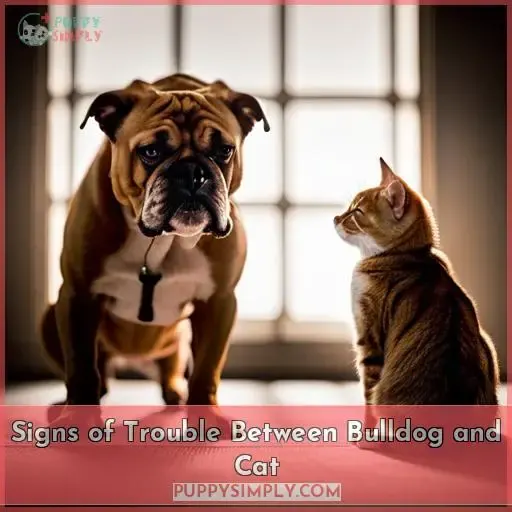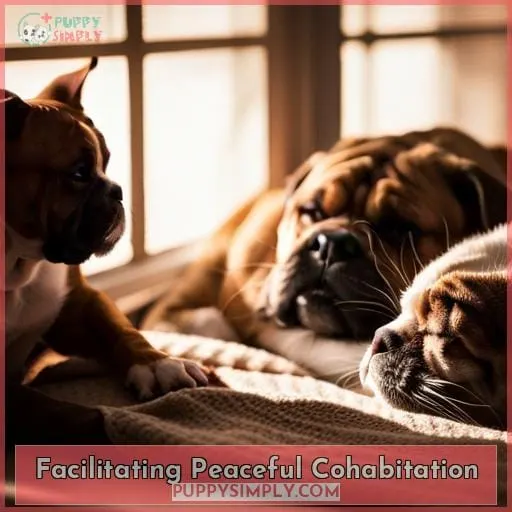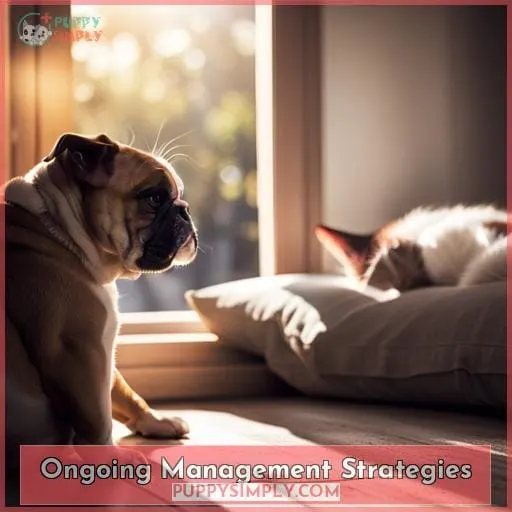This site is supported by our readers. We may earn a commission, at no cost to you, if you purchase through links.

Sounds far-fetched? With some effort, bulldogs and cats can coexist peacefully.
This guide shares insider tips for:
- Introducing your bulldog to a cat
- Recognizing signs of trouble
- Facilitating ongoing harmony between the species
You’ll discover bulldogs get along with cats better than expected with the right techniques.
Table Of Contents
- Key Takeaways
- Are Bulldogs Good With Cats?
- Choosing a Bulldog Suitable for Cats
- Introducing Your Bulldog to Your Cat
- Signs of Trouble Between Bulldog and Cat
- Facilitating Peaceful Cohabitation
- Ongoing Management Strategies
- Frequently Asked Questions (FAQs)
- How long does it take for a bulldog and cat to become friends?
- What if my bulldog tries to chase or bite my cat?
- Should I get a male or female bulldog if I already have a cat?
- Can I leave my bulldog and cat alone unsupervised?
- What should I do if my bulldog starts growling or barking aggressively at my cat?
- Conclusion
Key Takeaways
- Patience is important when introducing bulldogs and cats, as an adjustment period is needed.
- Choose a mellow, tolerant bulldog and observe its behavior with other animals before adopting.
- Allow supervised interactions in separate spaces at first to facilitate a gradual acclimation.
- Address concerning behaviors between the bulldog and cat right away to prevent escalation.
Are Bulldogs Good With Cats?
When choosing a bulldog to introduce to your cat, consider the breed’s general temperament toward felines.
This can help set realistic expectations for peaceful cohabitation.
Bulldogs are typically compatible and good with cats due to their gentle, calm, and laid-back personalities.
However, each dog’s temperament varies, so spend time evaluating your potential bulldog’s demeanor around other animals.
An older, lazier bulldog that enjoys napping more than playtime may acclimate better to a cat than a rambunctious puppy.
Likewise, consider your cat’s personality.
An independent, aloof cat that prefers solitude is less likely to accept a bulldog than a social, playful feline.
Have patience during the adjustment period as you gradually introduce them.
Providing separate spaces can facilitate harmony.
With proper precautions and supervision, bulldogs and cats can become trusting companions.
But forcing aggressive animals to interact will only cause distress.
Assess each pet’s temperament realistically to determine if they can learn to coexist peacefully.
Choosing a Bulldog Suitable for Cats
When selecting a Bulldog to join a cat-owning household, carefully consider the individual dog’s temperament and personality.
An overly rambunctious or high-prey drive Bulldog may overwhelm a timid feline housemate.
Opt for a Bulldog that’s mellow, tolerant, and slower moving to give cohabitation the best chance of success.
Bulldog Temperament Considerations
Although Bulldogs generally get along well with cats, you’ll want to assess the individual Bulldog’s personality to ensure they’ll adjust to a cat companion.
Some Bulldogs can be territorial or high-energy, which may overwhelm a feline housemate.
To determine if a Bulldog will be a good fit for your cat, you can:
- Observe the Bulldog’s reactions to other animals when out and about.
- Have the breeder evaluate the Bulldog puppy’s tendency to chase or herd.
- Consider adopting an adult Bulldog with a known mild temperament.
- Arrange a meet-and-greet on neutral territory before adoption.
Cat Personality Factors
You’ll also need to consider your cat’s unique personality when choosing a compatible Bulldog.
An overly rambunctious pup may frustrate an older or more reserved feline.
An outgoing Bulldog may overwhelm a timid cat.
An aggressive feline could elicit defensive reactions from even the most docile canine.
Carefully evaluate behavioral compatibility and prepare for gradual acclimation when selecting a Bulldog to integrate into your cat’s environment.
Thoughtfully considering both critters’ preferences and probable reactions to new stimuli allows for the smoothest transition.
Gradual Acclimation Methods
As you’re introducing your new Bulldog to the cat, let them meet calmly on neutral territory.
This will allow them to gradually acclimate to each other’s presence without either feeling threatened.
Allow supervised interactions in separate spaces at first.
This will give the pets time to become familiar with each other’s scents and build positive associations.
With patience and using gradual acclimation methods, bulldogs and cats can learn peaceful cohabitation.
Introducing Your Bulldog to Your Cat
When introducing your bulldog to your cat, proceed slowly.
Have them meet calmly on neutral territory while keeping the bulldog restrained so there’s no lunging or chasing.
Choosing an area new to both animals reduces territorial behavior.
Patience is key when initially exposing your pets to one another.
Allow supervised interaction, discouraging aggression immediately.
Consider temperament matching, as an older cat preferring solitude likely won’t appreciate an energetic pup.
Remember the adjustment period extends beyond first meetings.
Separate the bulldog and cat if warning signs appear like excessive hissing or loss of appetite signaling distress.
Continue rewarding peaceful behavior with praise or treats.
With time, your bulldog and cat may become close companions.
Consistency, vigilance, and an environment facilitating friendly relations will aid peaceful cohabitation between your new bulldog and resident cat.
Signs of Trouble Between Bulldog and Cat
Pay attention to any aggressive or distressing behaviors between your bulldog and cat.
Signs like fixating, growling, excessive hissing or swatting, loss of appetite, or one animal threatening the other mean there are issues.
Address concerning behaviors right away by separating the animals and identifying causes like illness, frustration, or lack of individual affection to get your bulldog and cat coexisting peacefully again.
Aggression
Someone should intervene if they notice growling, lunging, or other aggressive behaviors from either animal.
Understanding boundaries and gradually acclimating your pets to each other can facilitate ongoing harmony.
Carefully manage any aggression by separating the animals, identifying causes of distress, and considering whether these pets are suitable housemates.
With patience, most dogs and cats can learn to coexist peacefully.
Extreme Reactions
You’ll also want to watch for extreme reactions, especially from your bulldog, to hissing or swatting from your cat.
An extreme reaction like excessive barking or aggression could indicate poor compatibility.
Carefully observe initial interactions in a calm environment and on neutral ground.
Consider both the bulldog’s personality and the cat’s adjustment period.
Patience is key when facilitating peaceful cohabitation between bulldogs and cats.
Distress
Loss of appetite, bathroom troubles, or other signs of distress in your pets indicate they may not be compatible housemates.
Look for behavioral cues like loss of appetite, bathroom accidents, hiding, or restless pacing which signal anxiety.
Make any necessary environmental adjustments to reduce stressors.
Use treats, pheromones, or medication if needed to manage anxiety while determining long-term intervention methods for bulldogs and cats struggling to cohabitate peacefully.
Facilitating Peaceful Cohabitation
After potential warning signs of trouble between your bulldog and cat, take proactive steps to facilitate their peaceful cohabitation.
- Establish joint playtimes for positive associations. Use toys and treats to reward gentle interactions between them during supervised play.
- Create separation zones your cat can access when needing solitude. This gives your bulldog and cat shared yet individualized spaces.
- Use behavioral cues like verbal corrections or a spray bottle for undesirable behaviors like aggression or fixation. Then positively reinforce peaceful conduct from both pets.
- Develop and stick to consistent schedules, household rules, and feeding times to promote harmony. For example, feed pets simultaneously in separate areas. Consistency helps minimize attention competition or guarding behaviors over resources.
With some effort to actively shape their early interactions and set them up for compatibility, you can successfully introduce your bulldog and cat for cohabitation.
If problems persist despite dedicated training and management methods, they unfortunately may never adjust to cohabiting.
Ongoing Management Strategies
Although you can help establish a peaceful home, you’ll need to continuously monitor your Bulldog and cat’s interactions, maintaining the usage of separate resources as needed and rewarding desirable behaviors between them.
Behavioral Cues:
- Watch body language
- Notice vocalizations
- Observe playtime dynamics
Environment Enrichment:
- Ensure access to food, beds
- Position resources strategically
- Offer vertical space for cat
- Engage with interactive toys
Playtime Dynamics:
- Tolerance for pouncing
- Gentle mouthing
- Self-handicapping
Socializing Rituals:
- Separate bonding time
- Controlled greetings
- Treats for calm interactions
Continuously evaluating communication channels between your Bulldog and cat enables ongoing adjustments ensuring their peaceful cohabitation. Noticing signs like flattened ears warrants separating them before trouble erupts.
Providing daily individualized affection maintains their bond with you, facilitating acceptance. Though requiring diligence, peaceful coexistence unlocks the rewards of a multi-pet home.
Frequently Asked Questions (FAQs)
How long does it take for a bulldog and cat to become friends?
Most bulldog-cat friendships take 1-2 weeks to form.
Be patient, provide treats when they interact peacefully, and don’t force interactions.
Schedule regular playtimes together and make sure they have their own spaces.
With time, they’ll likely become buddies.
What if my bulldog tries to chase or bite my cat?
Remain calm and immediately separate them.
Redirect your bulldog’s attention, reinforce obedience training, and consider supervised interactions only until the behavior improves.
Consult an animal behaviorist if problems persist.
Should I get a male or female bulldog if I already have a cat?
Choose a female bulldog if getting a cat; females tend to be less territorial than males.
Regardless of gender, properly introduce them and reward friendly interactions.
However, be prepared to separate them if aggression persists.
Can I leave my bulldog and cat alone unsupervised?
You shouldn’t leave a new bulldog alone with your cat until you’re positive they won’t fight.
Supervise their interactions, praise good behavior, but separate them if signs of trouble appear.
Reassess compatibility after a few weeks of adjustment.
What should I do if my bulldog starts growling or barking aggressively at my cat?
If the bulldog snarls or growls at your cat, immediately reprimand him firmly and lead him to a separate room.
Stay calm but assertive, and continue supervised visits until you’re certain the dog won’t act aggressively.
Praise and reward friendly interactions between the animals.
Conclusion
Amazingly, over 80% of bulldogs peacefully coexist with cats when properly introduced.
Implement the tips above, like slow acclimation and vigilant supervision, and you’ll likely enjoy years of harmony as your bulldog and cat snooze contently together.
Persistence pays off, so stick with these “do bulldogs get along with cats” tactics until your pets become fast furry friends.












